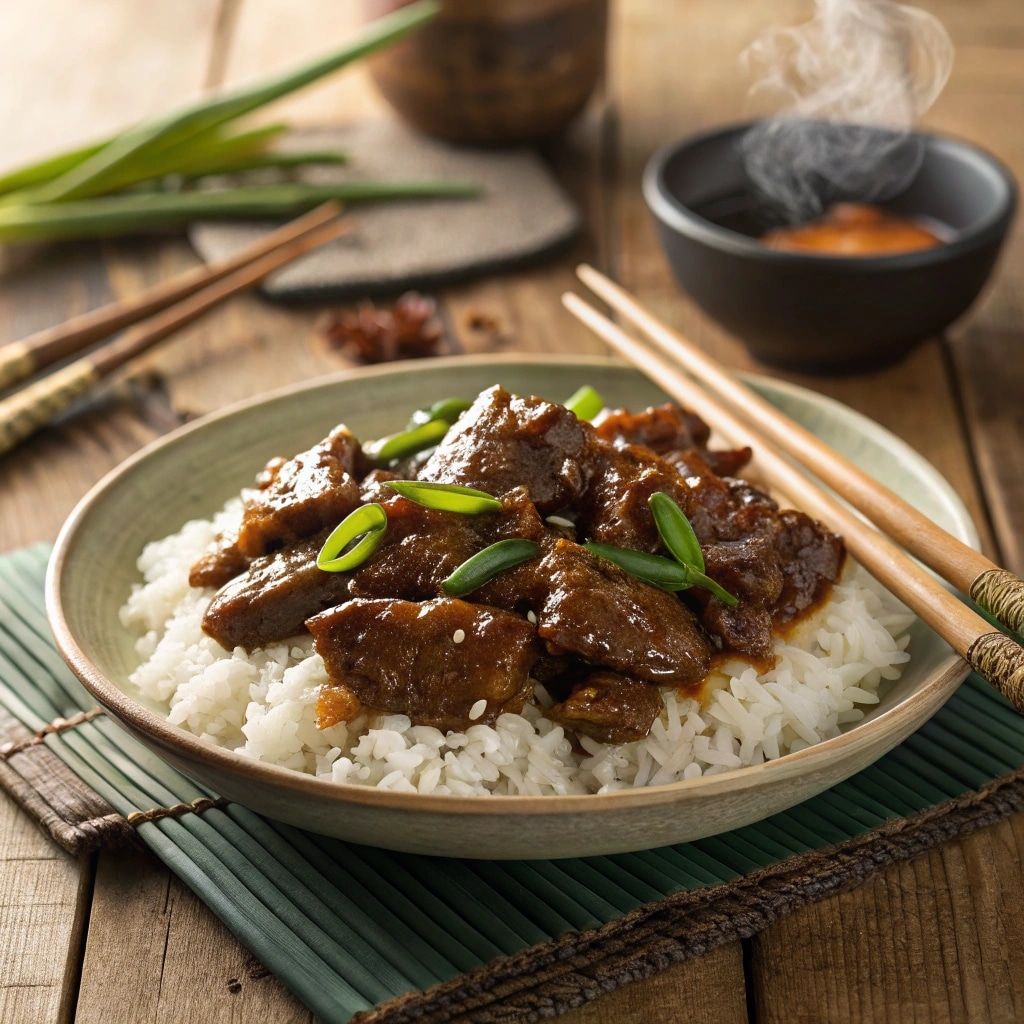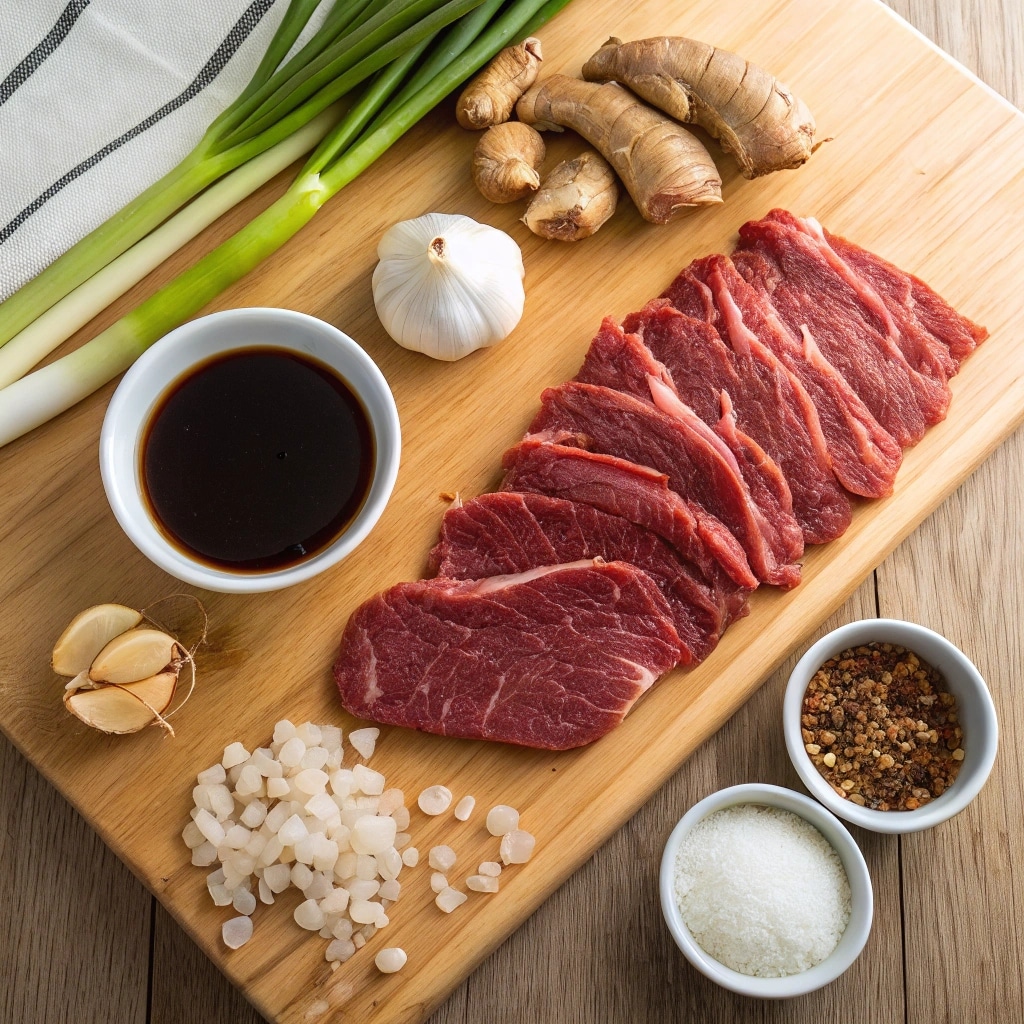Mongolian Beef is more than a dish; it’s a celebration of cherished family memories and culinary creativity. This article explores what makes Mongolian Beef special, unlocking the real story behind the name, the secret to its irresistible tenderness, and how you can create a restaurant-worthy version at home. Along the way, you’ll discover expert-approved techniques, practical marinating insights, authentic tips for incredible texture, and the fascinating roots of this American-Chinese favorite, all woven with the heritage of Sofia Morel and her kitchen traditions.

Table of Contents
Introduction
Mongolian Beef is a plate of comfort that brings together savory-sweet saucy beef, gentle aromas of garlic and ginger, and the kind of warmth that feels like home. Inspired by Sofia Morel’s family heritage, this dish holds a special place at Menumaison, reminding her of the laughter-filled nights spent perfecting each stir fry with her mother. The heart of every delicious bite lies in tradition, from patiently marinating to the lively sizzle of beef in a hot wok. Get ready for an in-depth journey into what sets Mongolian Beef apart, practical tips for tenderness, and an easy-to-follow recipe that you’ll want to make again and again.
Print
How To Make The BEST Mongolian Beef At Home Fast & Delicious
- Total Time: 35 min
- Yield: 4 servings 1x
Description
Classic Mongolian Beef: tender slices of beef, marinated and stir-fried, coated in a savory-sweet garlic soy sauce. A restaurant icon you can easily make at home.
Ingredients
1 lb flank steak, thinly sliced
2 tsp soy sauce
2 tsp Shaoxing wine (or dry sherry)
1 tbsp cornstarch (+ extra for dredging)
1/2 tsp baking soda
2 tbsp water
1 tbsp neutral oil
1/2 cup brown sugar
1/4 cup low sodium soy sauce
1/3 cup water
3 cloves garlic, minced
1 tbsp ginger, minced
3 scallions, cut in 1” pieces
steamed jasmine rice (for serving)
Instructions
1. Mix sliced beef with soy sauce, Shaoxing wine, water, cornstarch, and baking soda. Marinate for 30 min–2 hrs.
2. Mix brown sugar, 1/4 cup soy sauce, 1/3 cup water, garlic, and ginger in a bowl.
3. Toss marinated beef in extra cornstarch until coated and shake off excess.
4. Heat 1/2 of the oil in a large wok over high heat; cook beef in small batches, about 1–2 min per side, until browned. Remove and set aside.
5. Add remaining oil to wok. Pour in sauce mixture, scraping up browned bits, and bring to a simmer.
6. Return beef to wok. Toss with sauce and let thicken for 2–3 min.
7. Stir in scallions and cook 1 min more.
8. Serve beef and sauce over rice. Garnish with extra scallions or sesame seeds if desired.
Notes
Flank steak is classic, but top sirloin or NY strip can be used.
Marinate overnight for deeper flavor, but don’t exceed 24 hours.
For gluten-free, use tamari instead of regular soy sauce.
Recipe easily doubles for meal prep or large gatherings.
- Prep Time: 15 min
- Cook Time: 20 min
- Category: Beef
- Method: Stir Fry
- Cuisine: American Chinese
Nutrition
- Serving Size: 1 plate
- Calories: 420
- Sugar: 15g
- Sodium: 980mg
- Fat: 16g
- Saturated Fat: 4g
- Unsaturated Fat: 10g
- Trans Fat: 0g
- Carbohydrates: 35g
- Fiber: 1g
- Protein: 28g
- Cholesterol: 70mg
Mongolian Beef’s Unique Story and Appeal
Sofia’s Memory: The First Taste of Mongolian Beef
Every time Sofia prepares Mongolian Beef, she can’t help but recall her first taste at a family friend’s kitchen. The sweet, slightly caramelized aroma drew her in. As she watched thin ribbons of marinated beef hit the hot skillet, she learned the magic was in the simple transformation: that golden, sticky sauce sticking to each piece. Her mother leaned over and whispered, “This is how you make beef memorable don’t rush it, and let every bite count.” That memory became her gold standard she could taste the love, the patience, and the hint of mischief in every forkful.
What Makes Mongolian Beef So Special?
Mongolian Beef stands out for its perfect balance of sweet and savory, created by pan-seared beef tossed in a sauce built from soy, brown sugar, garlic, and ginger. The beef is always sliced thin flank steak is classic so every piece becomes tender and flavorful. The sauce often clings in a glossy coat, making every mouthful satisfying.
Some versions add a mellow kick of scallions, sliced onions, or bell peppers for freshness and color. The true magic lies not only in the ingredients, but in the technique behind them. The beef gets a velvet-soft texture thanks to a smart marinade: a combination of soy, cornstarch, and a touch of baking soda, which holds in moisture and tenderizes the meat as it marinates. This gives Mongolian Beef that instantly recognizable silkiness.
The Taiwanese-American Legacy
Despite its name, Mongolian Beef started its story in Taiwan, not Mongolia. In the 1950s, inventive cooks at “Mongolian barbecue” restaurants dreamed up a dish that took the stage in American-Chinese cuisine. With its glossy sauce, irresistible aroma, and quick-cooked beef, Mongolian Beef quickly became a menu legend from coast to coast. Sofia loves telling guests how the name “Mongolian Beef” was more about clever marketing than geography but the dish’s flavor speaks a universal language everyone can appreciate.
Marinating and Tenderizing Techniques for Perfect Mongolian Beef
Why Marination Matters: Turning Simple Into Sensational
Marination is the not-so-secret step that turns ordinary beef into something extraordinary. Sofia remembers her mother teaching her to always work the marinade into every slice, ensuring the flavors seep deep and the meat stays juicy. For Mongolian Beef, a classic marinade includes light soy sauce, Shaoxing wine, cornstarch, water, and a pinch of baking soda, which breaks down tough fibers and keeps every bite tender. Letting the beef marinate for at least 30 minutes ensures both flavor infusion and optimal tenderness it’s one reason this dish stays juicy and melt-in-your-mouth instead of chewy.

How Long Should You Marinate Mongolian Beef?
The ideal marinating time depends on the cut. Flank steak or skirt steak, being thin, absorb flavors rapidly 30 minutes to 2 hours is usually perfect. Marinating overnight is also a classic move for a stronger taste, but avoid over-marinating, as the texture can become too soft or even mushy. Internal kitchen wisdom: for extra flavor without extra fuss, cover and refrigerate your beef during marination. Turn the slices occasionally for even soaking. And always discard leftover marinade for food safety.
Velveting: The Restaurant Method for Ultra-Tender Beef
Ever wonder how restaurants get their Mongolian Beef so incredibly tender? The method is called velveting. After marinating, coat the beef with cornstarch (sometimes with a dash of baking soda). This forms a delicate shield that locks in the juices during high-heat cooking, keeping the center soft and moist. With these steps, even an inexpensive cut turns into something remarkable on the plate.
| Beef Cut | Recommended Marinating Time |
|---|---|
| Flank Steak / Skirt Steak | 30 min – 2 hrs |
| Top Round / Tri-Tip | 4 – 6 hrs |
| Chuck Roast / Bottom Round | 6 – 12 hrs |
| Overnight | Up to 24 hrs for bolder flavor |
Looking for more flavor development tips? Sofia also shares secrets behind Marinated Flank Steak and quick stir fry recipes using fresh local produce on Menumaison.
Classic Mongolian Beef Preparation Step-by-Step
Selecting the Best Cuts and Slicing Techniques
Achieving authentic Mongolian Beef starts with choosing the right cut. Flank steak and sirloin are top picks for their balance of flavor and tenderness. For best results, always slice against the grain in thin strips this breaks up muscle fibers and keeps every bite tender. Sofia suggests freezing the beef for 15–20 minutes before slicing; it firms the meat, making precision cuts easy and quick to achieve.
Prepping the Sauce and Building Flavor
In Sofia’s kitchen, the sauce comes together in minutes: a harmonious blend of soy sauce, brown sugar (or dark brown for deeper caramel notes), fresh garlic, and ginger creates the hallmark flavor of Mongolian Beef. Sometimes, a pinch of red pepper flakes is added for gentle warmth. She dissolves the sugar in hot water or stock before stirring in the rest, ensuring a smooth, glossy finish. The sauce should taste balanced sweet, salty, with just enough ginger heat.
Stir-Frying: Quick Cooking for Juicy Results
Cook the beef in small batches in a hot wok or skillet, using a neutral oil. Quickly searing the slices forms a golden crust and seals in their moisture. Sofia warns never to overcrowd the pan work in small batches for true restaurant quality, and add more oil as needed. After all the beef is browned, return it to the pan with the sauce and simmer for 2–3 minutes, tossing to coat every morsel. Scallions or slivered onions go in last to keep their color and snap.
Key Steps to Mongolian Beef Perfection
| Step | Key Detail |
|---|---|
| Slice Beef Against Grain | Ensures tenderness in every bite |
| Velvet with Cornstarch | Locks in juices, forms crisp coating |
| Cook Quickly in Batches | Prevents steaming; brings caramelized surface |
| Finish with Fresh Scallions | Adds crunch, color, and gentle spice |
Serving, Variations, and The True Origin of Mongolian Beef
Serving Ideas and Homemade Variations
Sofia serves Mongolian Beef over fluffy steamed jasmine rice, but you can substitute brown rice, fried rice, or even crispy noodles for texture difference. Extra sauce can be spooned on vegetables or used for dipping. For a lighter option, try spooning the juicy beef over a bed of sautéed bok choy, broccoli, or mixed peppers. Make it gluten-free by using tamari or coconut aminos instead of soy sauce, and feel free to add sliced bell peppers or carrots for crunch and color.
How Did Mongolian Beef Get Its Name?
This is where the story gets as rich as the flavor. Despite its daring name, Mongolian Beef didn’t come from Mongolia. It actually originated in 1950s Taiwan, where “Mongolian barbecue” restaurants served up stir-fried creations to draw in curious diners. The name was more about intrigue than authenticity real Mongolian cuisine leans heavily on boiled meats and dairy. When the dish made its way to the U.S., it quickly became a staple of American-Chinese menus. For Sofia, the way food picks up new identities and stories over time is just as exciting as the taste itself telling those stories is part of what makes every meal meaningful.
Conclusion
From Sofia’s kitchen to yours, Mongolian Beef brings with it the warmth of tradition and the satisfaction of mastering a timeless favorite. With its savory sauce, tender beef, and storied past, it’s a dish you’ll find yourself making over and over again. Perfect your technique with thoughtful marination and real restaurant tricks, and bring your own stories to every meal you serve.
